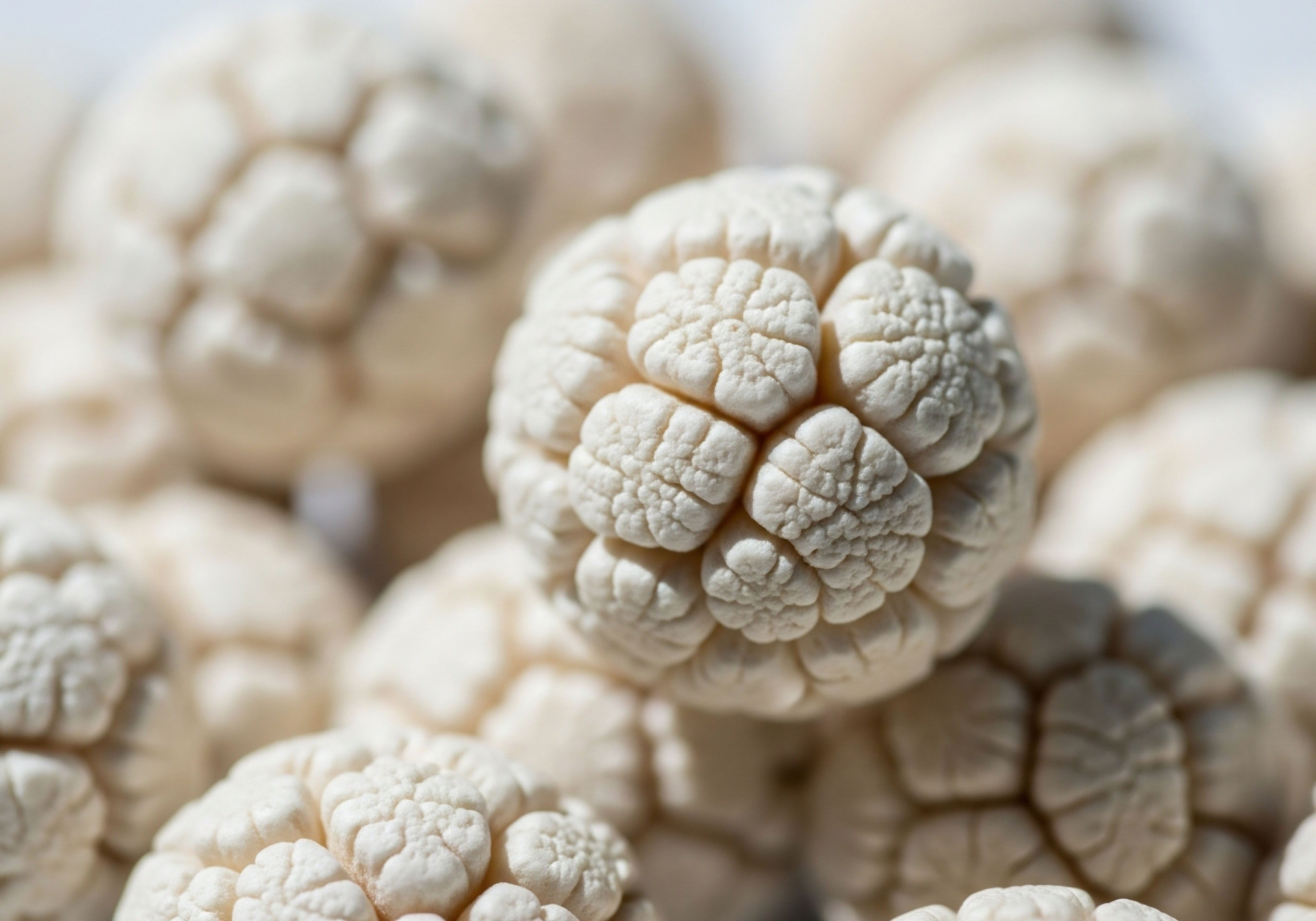

Fundamentals
You feel it before you can name it. A subtle shift in your energy, a change in your sleep, a new pattern in your monthly cycle, or a frustrating lack of progress in your fitness goals. These experiences are not just in your head; they are coded in your biology, written in the language of hormones.
When we talk about hormonal health, particularly the intricate world of estrogen, we are discussing the very system that regulates your vitality. Understanding how your daily choices, especially the food you consume, directly influence this system is the first step toward reclaiming control over your biological narrative.
Your body does not have a single “estrogen.” Instead, it produces a family of estrogens, primarily estrone (E1), estradiol (E2), and estriol (E3). Each has a distinct role and potency, acting like a set of keys designed to fit into specific locks, known as estrogen receptors, located on cells throughout your body ∞ in your brain, bones, muscles, and reproductive organs.
The journey of these hormones is a continuous cycle of production, action, and elimination. This cycle is not isolated; it is profoundly influenced by a network of organ systems working in concert, with your dietary choices acting as a primary conductor of this complex orchestra.

The Core Regulators of Estrogen
To grasp how food alters your estrogen levels, we must first appreciate the key biological players involved in its lifecycle. Think of it as a corporate supply chain ∞ there’s a manufacturing department, a distribution network, and a waste management facility. Each stage is critical for maintaining a balanced inventory.

Production Centers
In premenopausal women, the ovaries are the primary factories for estrogen production. However, your adrenal glands and, significantly, your adipose (fat) tissue also contribute. In men and postmenopausal women, adipose tissue becomes a principal site of estrogen synthesis. An enzyme within fat cells called aromatase converts androgens (like testosterone) into estrogen. This is a crucial point ∞ the more adipose tissue you have, the greater your capacity for this conversion, which can directly impact your overall hormonal balance.

The Hepatic Processing Plant Your Liver
Once estrogen has circulated through the bloodstream and delivered its messages, it must be deactivated and prepared for removal. This critical task falls to the liver. Through a two-phase detoxification process, the liver chemically modifies estrogen molecules, packaging them into a water-soluble form that can be safely excreted from the body.
The efficiency of these Phase I and Phase II detoxification pathways is entirely dependent on a steady supply of specific nutrients ∞ vitamins, minerals, and amino acids ∞ that you can only obtain from your diet.

The Final Gateway the Gut
After the liver processes them, conjugated (deactivated) estrogens are sent to the gut for final elimination. Here, another fascinating system comes into play ∞ your gut microbiome. A specific collection of gut bacteria, now known as the estrobolome, produces an enzyme called beta-glucuronidase.
This enzyme can “un-package” the deactivated estrogens, allowing them to be reabsorbed back into circulation. The composition of your gut flora, which is directly shaped by your diet, determines the level of this enzymatic activity and, consequently, how much estrogen is recycled versus how much is eliminated.
Your daily food choices are not passive fuel; they are active biological instructions that modulate estrogen production, detoxification, and elimination.
This interconnected system ∞ fat tissue, liver, and gut ∞ forms the foundation of your body’s ability to regulate estrogen. Every meal provides a new set of instructions that can either support or disrupt this delicate balance. By understanding these fundamental mechanisms, you can begin to see your diet as the powerful tool it is for shaping your hormonal health from the inside out.


Intermediate
Moving beyond the foundational knowledge of estrogen’s lifecycle, we can now examine the specific biochemical mechanisms through which dietary components directly interact with and modulate hormonal pathways. Your nutritional intake provides the raw materials and cofactors that govern enzymatic reactions, influence gene expression, and shape the microbial environment of your gut. This is where the science of nutrition becomes a practical application for personalized wellness, allowing for targeted adjustments that can recalibrate your endocrine system.

The Gut Microbiome the Estrobolome Effect
The concept of the estrobolome represents a significant advancement in our understanding of hormone regulation. This specialized consortium of gut microbes directly gates the amount of estrogen that re-enters circulation. The primary mechanism involves the bacterial enzyme beta-glucuronidase. After the liver conjugates estrogen in Phase II detoxification, it is sent to the bowel for excretion.
However, certain gut bacteria can produce beta-glucuronidase, which deconjugates the estrogen, essentially setting it free to be reabsorbed through the intestinal wall back into the bloodstream.
A diet low in dietary fiber and high in processed foods can lead to an overgrowth of bacteria that produce high levels of beta-glucuronidase. This results in greater estrogen reactivation and reabsorption, contributing to a higher systemic estrogen load. Conversely, a diet rich in diverse plant fibers nourishes a different set of microbes.
These beneficial bacteria help maintain the integrity of the gut lining and produce short-chain fatty acids (SCFAs) like butyrate, which supports overall gut health and helps regulate the microbial balance, thereby reducing beta-glucuronidase activity.
- Soluble Fiber ∞ Found in oats, barley, apples, and beans, it forms a gel-like substance that binds to bile acids containing conjugated estrogens, ensuring their excretion.
- Insoluble Fiber ∞ Present in whole grains and vegetables, it increases fecal bulk and accelerates transit time, reducing the window for beta-glucuronidase to act on estrogens.

How Does the Liver Process Estrogen?
The liver’s role in estrogen detoxification is a sophisticated, two-step process. The efficiency of these pathways is highly dependent on specific nutrient availability. Any bottleneck in this system can lead to a buildup of estrogen or its more potent and potentially harmful metabolites.

Phase I Hydroxylation
In Phase I, cytochrome P450 enzymes modify estrogen molecules through a process called hydroxylation. This creates three main metabolites:
- 2-hydroxyestrone (2-OHE1) ∞ Considered the “favorable” metabolite due to its weak estrogenic activity and protective properties.
- 4-hydroxyestrone (4-OHE1) ∞ A more potent metabolite that can generate free radicals and has been linked to DNA damage if not properly cleared in Phase II.
- 16-alpha-hydroxyestrone (16α-OHE1) ∞ The most potent of the three, with strong estrogenic effects.
Dietary compounds found in cruciferous vegetables (broccoli, cauliflower, kale, Brussels sprouts), such as Indole-3-carbinol (I3C) and its derivative 3,3′-Diindolylmethane (DIM), have been shown to favorably shift this process. They upregulate the enzymes that produce the protective 2-OHE1 metabolite, effectively steering estrogen down a healthier detoxification pathway.
The balance of estrogen metabolites is a key determinant of hormonal health, and it can be directly influenced by the phytonutrients in your diet.

Phase II Conjugation
In Phase II, the liver attaches another molecule to the hydroxylated estrogens to neutralize them and make them water-soluble for excretion. This requires several sub-pathways, each with its own nutrient dependencies.
| Pathway | Function | Required Nutrients | Dietary Sources |
|---|---|---|---|
| Methylation | Attaches a methyl group, deactivating potent estrogen metabolites like 4-OHE1. Critical for clearing catechol estrogens. | B6, B12, Folate, Magnesium, Methionine | Leafy greens, legumes, seeds, nuts, lean protein |
| Glucuronidation | Attaches glucuronic acid, a major pathway for clearing estrogens. Can be reversed by beta-glucuronidase in the gut. | Calcium-D-Glucarate, Glucuronic Acid | Apples, oranges, broccoli, Brussels sprouts |
| Sulfation | Attaches a sulfur group. This pathway can become depleted with high toxin exposure or poor dietary sulfur intake. | Sulfur, Molybdenum, Taurine, Cysteine | Garlic, onions, eggs, cruciferous vegetables |

The Role of Adipose Tissue and Dietary Fats
Adipose tissue is a significant endocrine organ, particularly concerning estrogen. The enzyme aromatase, present in fat cells, converts androgens into estrone. In states of excess body fat and associated insulin resistance, aromatase activity is often upregulated. This creates a self-perpetuating cycle where higher insulin levels promote fat storage, and the increased fat tissue produces more estrogen, which can further drive fat accumulation in certain patterns.
The composition of dietary fats also plays a role. While research is ongoing and sometimes presents mixed findings, some studies suggest that high intakes of saturated fats may be associated with higher circulating estrogen levels. Conversely, omega-3 fatty acids, found in fatty fish, flaxseeds, and walnuts, have anti-inflammatory properties that can help improve insulin sensitivity, indirectly supporting healthier estrogen balance by mitigating the effects of excess adipose tissue.
This detailed view shows that dietary changes alter estrogen levels through a multi-pronged approach ∞ managing gut microbial activity, providing essential cofactors for liver detoxification, and influencing the endocrine activity of fat tissue. This integrated perspective is essential for developing effective, personalized nutritional strategies for hormonal health.


Academic
An academic exploration of dietary influence on estrogen metabolism necessitates a systems-biology perspective, moving beyond isolated nutrient actions to an integrated understanding of how nutritional inputs modulate a complex network of genetic, enzymatic, and microbial interactions. The central thesis is that diet does not merely raise or lower estrogen; it recalibrates the entire Integrated Estrogen Metabolism System (IEMS).
This system encompasses the Hypothalamic-Pituitary-Gonadal (HPG) axis, hepatic biotransformation pathways, the gut estrobolome, and the peripheral endocrine activity of adipose tissue. We will focus specifically on the molecular interplay between dietary lignans, the gut microbiome, and estrogen receptor modulation as a prime example of this systemic regulation.

Phytoestrogens as Endocrine Modulators
Phytoestrogens, particularly lignans and isoflavones, are plant-derived polyphenolic compounds with a chemical structure similar to 17β-estradiol. This structural similarity allows them to bind to estrogen receptors (ERs), specifically ERα and ERβ. Their biological effect is not simply “estrogenic”; it is modulatory. Phytoestrogens exhibit a significantly higher binding affinity for ERβ compared to ERα.
This is of profound physiological importance because ERα and ERβ often mediate different, sometimes opposing, cellular actions. ERα activation is typically associated with proliferative signals, whereas ERβ activation is frequently linked to anti-proliferative and pro-apoptotic effects.
By preferentially binding to and activating ERβ, phytoestrogens can act as natural Selective Estrogen Receptor Modulators (SERMs). In a high-estrogen environment (e.g. premenopause), they can compete with the more potent endogenous estradiol for receptor binding sites, potentially dampening overall estrogenic signaling. In a low-estrogen environment (e.g. postmenopause), their weak agonistic activity at both receptors can provide a baseline level of estrogenic support. This dual action explains their context-dependent effects observed in clinical research.

The Lignan-Enterolignan Axis a Microbiome-Dependent Mechanism
Dietary lignans, abundant in flaxseeds, sesame seeds, and whole grains, are not biologically active in their native form. Their conversion into the active enterolignans ∞ enterolactone and enterodiol ∞ is entirely dependent on the metabolic action of the gut microbiota. This biotransformation is a multi-step process carried out by specific bacterial species.
Individuals who lack these specific microbes are “non-producers” of enterolignans, even with high dietary lignan intake. This highlights the microbiome as an obligatory gateway for the hormonal effects of these phytonutrients.
Enterolactone, the primary bioactive metabolite, has demonstrated a range of activities relevant to hormone-dependent conditions. Its ability to modulate ER signaling is complemented by its capacity to inhibit aromatase activity, thereby reducing the peripheral conversion of androgens to estrogens in adipose tissue. This dual mechanism ∞ receptor modulation and synthesis inhibition ∞ makes the lignan-enterolignan axis a powerful example of diet-hormone interaction.
The conversion of dietary lignans to active enterolignans by the gut microbiome is a critical control point in modulating systemic estrogenic activity.

Nutrigenomics and Estrogen Metabolism
The next layer of complexity involves individual genetic variations, or Single Nucleotide Polymorphisms (SNPs), in key enzymatic pathways. The efficacy of dietary interventions can be significantly influenced by an individual’s genetic makeup, a field known as nutrigenomics.
A critical enzyme in Phase II estrogen detoxification is Catechol-O-methyltransferase (COMT), which is responsible for methylating and thus deactivating the potent 4-hydroxyestrone metabolite. A common SNP in the COMT gene results in a less efficient version of the enzyme.
Individuals with this slower COMT variant may have a reduced capacity to clear potent estrogens, potentially increasing their risk for hormone-sensitive conditions. For these individuals, dietary strategies that support methylation become even more important. This includes ensuring an abundant intake of methyl donors like folate, B12, and methionine, and compounds like magnesium which is a cofactor for the COMT enzyme.
| Pathway/Component | Dietary Modulator | Molecular Mechanism of Action | Clinical Implication |
|---|---|---|---|
| Aromatase (CYP19A1) | Enterolactone (from Lignans), Chrysin, Apigenin | Competitive inhibition of the aromatase enzyme, reducing the conversion of androgens to estrogens in adipose and other peripheral tissues. | Supports balanced estrogen levels in conditions of excess adiposity or in men on TRT to manage aromatization. |
| Phase I (CYP1A1) | Indole-3-Carbinol (I3C) / DIM | Upregulates gene expression of CYP1A1, preferentially shifting hydroxylation toward the 2-OH pathway over the 4-OH and 16α-OH pathways. | Promotes a more favorable ratio of estrogen metabolites, reducing the burden of potent and potentially genotoxic forms. |
| Phase II (COMT) | Magnesium, B Vitamins (Folate, B12), Methionine | Serve as essential cofactors and methyl group donors for the COMT enzyme, facilitating the neutralization of catechol estrogens. | Crucial for individuals with low-activity COMT polymorphisms to ensure efficient clearance of 4-OHE1. |
| Gut Microbiome (β-glucuronidase) | Dietary Fiber (Soluble & Insoluble), Probiotics | Fiber binds conjugated estrogens for excretion and promotes a microbial environment that lowers beta-glucuronidase activity. | Reduces enterohepatic recirculation of estrogens, lowering the overall systemic estrogen load. |

What Are the Clinical Applications in Hormonal Therapies?
This systems-level understanding has direct applications for individuals undergoing hormonal therapies. For a man on Testosterone Replacement Therapy (TRT), managing the aromatization of testosterone to estradiol is a primary clinical goal to prevent side effects. A diet rich in lignans and cruciferous vegetables can provide natural aromatase inhibition and support efficient estrogen clearance, potentially working synergistically with prescribed medications like Anastrozole.
For a postmenopausal woman on hormone therapy, a diet that supports healthy liver detoxification and gut health ensures that the exogenous hormones are metabolized and eliminated efficiently, promoting optimal therapeutic outcomes while minimizing risks.
In conclusion, dietary interventions modify estrogen levels through a sophisticated and integrated network of effects. They provide SERM-like compounds, supply substrates for microbiome-dependent activation, deliver essential cofactors for hepatic biotransformation, and influence the genetic expression of key metabolic enzymes. A clinical approach that appreciates this complexity allows for the development of highly personalized and effective nutritional protocols to support endocrine health.

References
- Baker, M. E. “The estrobolome ∞ the gut microbiome and estrogen.” Journal of the Endocrine Society, vol. 3, no. 9, 2019, pp. 1645-1646.
- Kwa, M. Plottel, C. S. Blaser, M. J. & Adams, S. “The Intestinal Microbiome and Estrogen Receptor ∞ Positive Female Breast Cancer.” Journal of the National Cancer Institute, vol. 108, no. 8, 2016, djw029.
- Fuhrman, B. J. et al. “Dietary fiber intake and urinary estrogen and estrogen metabolites in premenopausal women.” Breast Cancer Research and Treatment, vol. 134, no. 3, 2012, pp. 1237-1246.
- Minich, D. M. & Bland, J. S. “A review of the clinical efficacy and safety of cruciferous vegetable phytochemicals.” Nutrition Reviews, vol. 65, no. 6, 2007, pp. 259-267.
- Bradlow, H. L. et al. “2-hydroxyestrone ∞ the ‘good’ estrogen.” Journal of Endocrinology, vol. 150, S259-S265, 1996.
- Desmawati, D. & Sulastri, D. “Phytoestrogens and their health effect.” Open Access Macedonian Journal of Medical Sciences, vol. 7, no. 3, 2019, p. 495.
- Patisaul, H. B. & Jefferson, W. “The pros and cons of phytoestrogens.” Frontiers in Neuroendocrinology, vol. 31, no. 4, 2010, pp. 400-419.
- Rodríguez-García, C. et al. “The role of the gut microbiome in the regulation of sex hormones.” Nutrients, vol. 13, no. 8, 2021, p. 2824.
- Wu, K. et al. “Fat intake, serum estrogen and androgen concentrations, and breast cancer risk in postmenopausal women.” Journal of the National Cancer Institute, vol. 90, no. 16, 1998, pp. 1226-1232.
- Oh, H. et al. “The role of aromatase in the development of obesity and insulin resistance in males.” The Journal of Steroid Biochemistry and Molecular Biology, vol. 137, 2013, pp. 1-7.

Reflection

Translating Knowledge into Personal Protocol
You have journeyed through the complex biological systems that connect the food on your plate to the hormonal signals that orchestrate your well-being. You now possess the understanding that your body is not a passive recipient of circumstance but an active, responsive system.
The information presented here is a map, detailing the intricate pathways of estrogen metabolism, the critical checkpoints in the liver, and the profound influence of the microbial allies in your gut. This knowledge is the foundation upon which you can build a new level of awareness.
Consider your own lived experience ∞ the symptoms you have felt, the health goals you aspire to achieve. How do they align with the biological mechanisms we have explored? See this as an invitation to become a more astute observer of your own physiology.
The path forward involves transforming this scientific understanding into a personalized practice, a protocol that is uniquely yours. This is a process of self-discovery, guided by data and informed by a deeper connection to your body’s internal communication network. Your biology is not your destiny; it is your dialogue.



